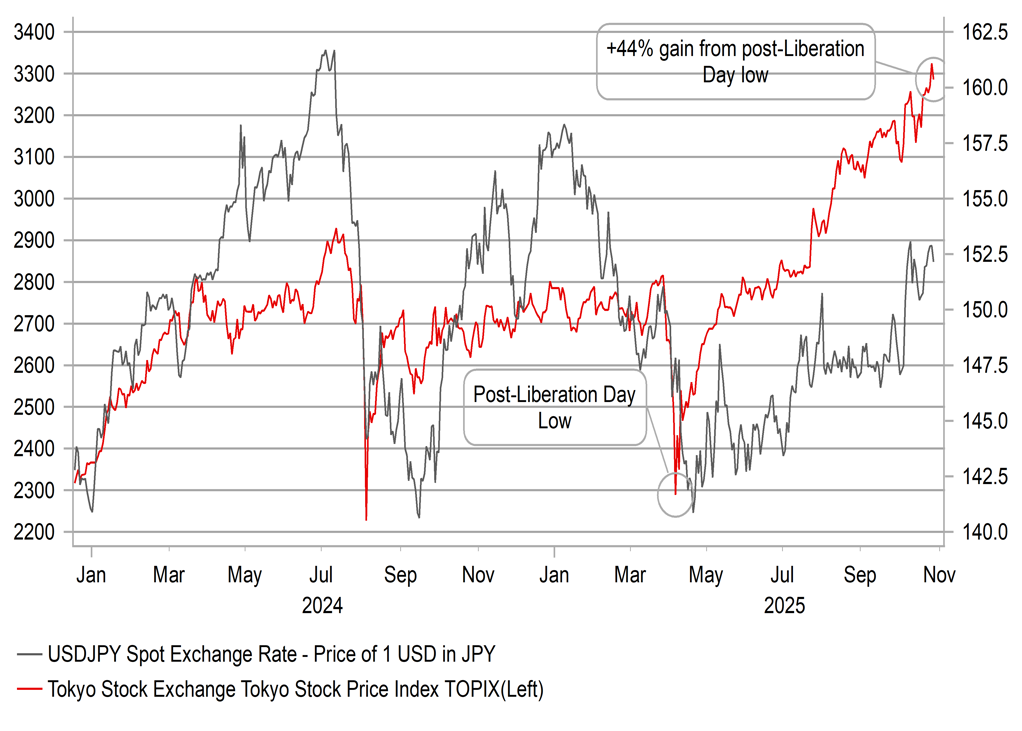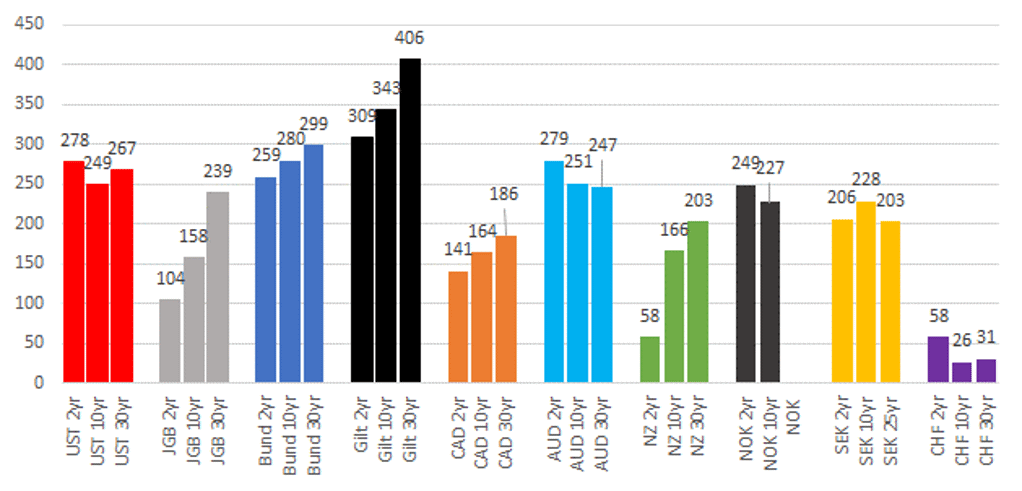Yen outperforms – did the US Treasury seek BoJ policy shift?
JPY: Yen selling momentum fading
At these levels in USD/JPY, the appetite for selling the yen is likely to be a lot weaker and the correction lower in equities – for no particular reason – was enough to prompt some renewed yen buying. This looks more like some profit-taking in equities after a strong gain fuelled by expectations of increased fiscal spending under new PM Takaichi. Some newswires are citing supportive comments from Japanese officials as being the factor behind the yen buying but those comments looked pretty standard to us. The broader move weaker for the US dollar ahead of the Fed policy meeting tomorrow was likely an underlying factor.
What is more likely a factor helping the yen from a political backdrop is not what the Japanese authorities said and more what the US authorities didn’t. US Treasury Secretary Scott Bessentt is well known for his criticism of BoJ monetary policy being behind the curve and being the primary cause of an under-valued yen. There were no explicit critical comments in Tokyo today but the US Treasury did release a statement on his meeting with Finance Minister Katayama. Bessentt reportedly “highlighted the
important role of sound monetary policy” and “preventing excess exchange rate volatility, as conditions are substantially different twelve years after the introduction of Abenomics”. This to us is a diplomatic way of saying that the current monetary stance is not what is required given the different inflation backdrop today in contrast to back in 2013 when the policies of Abenomics were being first being implemented. The statement was behind some of the yen buying on the perception that pressure had been put on Katayama to seek an adjustment in monetary policy. However, Finance Minister Katayama was quick to deny this stating the US Treasury statement did not reflect the US encouraging the BoJ to hike rates. However, we certainly view this US Treasury statement as conveying an underlying message that the current BoJ monetary stance, consistent with Abenomics-type policies, is no longer justified.
The JGB market remains broadly stable and yields have declined modestly with limited signs of a pick-up in concerns over increased fiscal spending. PM Takaichi has just again confirmed the government’s intention to increase defence spending but for now the targeting/strategic approach to increased spending and the lack of public comment on a sales tax cut on food is helping to keep JGB yields stable. For USD/JPY though the central bank decisions will be the focus now with the FOMC meeting tomorrow followed by the BoJ meeting on Thursday. If there was pressure put on Katayama by Bessentt in their meeting today, we could well see Governor Ueda signal a rate hike is on the agenda for the upcoming meetings in December and January.
TOPIX INDEX UP 44% FROM POST-LIBERATION DAY LOW

Source: Bloomberg, Macrobond & MUFG GMR
GBP: Gilt yields drop on budget speculation
The falling yield momentum in the UK Gilt market continues with the broader decline in US yields helping but certainly this is being reinforced by increased expectations that the BoE will be in a position to cut rates sooner than expected after the weaker than expected September inflation data released last week. Food inflation came in at 4.5% compared to the BoE’s estimate of 5.0% - while other measures missed to the downside, food inflation had been highlighted by BoE members as being problematic given it was a crucial component in shaping household inflation expectations. The 2-year Gilt yield is now down 21bps so far in October with the 10-year Gilt yield down 30bps and the 30-year yield down 33bps. The equivalent UST bond 30-year yield is down 16bps. In Germany, the 30-year bund yield is down just 10bps and in Japan the equivalent yield is down just 7bps.
So there is a substantial outperformance in longer-term Gilts compared to the other key G4 bond markets. Of course, Gilts have been the worst performing of those sovereign bond markets since the global inflation shock commenced. As can be seen in the chart, the outright increase in yields since the end of 2021 in each of the key tenors were the largest for UK Gilts. Within that period we did of course have the Liz Truss episode so for sure there is likely an added fiscal risk premium relative to other markets. But additionally, the evidence is also clear that UK inflation is stickier and wages have stayed more elevated. Japan’s inflation may be in the running for that – and indeed the 30-year increase in yields relative to the increase in 2-year yields is actually largest in Japan. But for the UK, the sticky inflation view may now be starting to change if the surprise downside inflation print last week is the start of a sustained turn lower.
But fiscal risks could also now be helping to drive yields lower as well. Media speculation is pointing toward the potential for the government to push for a notable increase in ‘headroom’ in the budget so that there is no need to repeat the exercise of trying to regain credibility with further fiscal measures through either more tax increases or spending cuts. The OBR is set to provide the government with the economic forecasts ‘pre-budget measures’ this Friday and there is speculation the OBR will downgrade productivity assumptions but that the impact may not be as bad as feared due to other offsetting factors. Rachel Reeves at the ‘Davos in the Desert’ yesterday spoke of the importance of having ‘sufficient headroom’.
Doubling the headroom from GBP 10bn to GBP 20bn is what we feel is required in order to make a meaningful difference and help lift investor confidence. Of course how that is achieved will be key as well. What seems clear at this stage is that the budget challenge could do with the help of monetary support if inflation is now heading lower. Improved fiscal confidence is a supportive factor to consider for the pound but over the short-term growth concerns and increased BoE rate cut expectations are likely to dominate and weigh on GBP performance. We continue to expect a grind higher in EUR/GBP to the 0.90-level.
G10 CHANGES IN KEY SOVEREIGN YIELD MATURITIES SINCE THE END OF 2021 TO LATEST – UK STAND OUT

Source: Bloomberg & MUFG Research; rates as of 27th October 17:00 GMT
KEY RELEASES AND EVENTS
|
Country |
GMT |
Indicator/Event |
Period |
Consensus |
Previous |
Mkt Moving |
|
IT |
09:00 |
Italian Business Confidence |
Oct |
-- |
87.3 |
! |
|
IT |
09:00 |
Italian Consumer Confidence |
Oct |
-- |
96.8 |
! |
|
EC |
09:00 |
ECB 1-Year CPI Expectations |
Sep |
2.80% |
!! |
|
|
EC |
09:00 |
ECB 3-Year CPI Expectations |
Sep |
2.50% |
2.50% |
!! |
|
EC |
09:00 |
ECB Bank Lending Survey |
-- |
-- |
-- |
!! |
|
EC |
09:30 |
ECB's Panetta speaks |
!! |
|||
|
US |
13:00 |
House Price Index (MoM) |
Aug |
0.1% |
-0.1% |
! |
|
US |
13:00 |
House Price Index (YoY) |
Aug |
-- |
2.3% |
! |
|
US |
13:00 |
S&P/CS HPI Composite - 20 n.s.a. (YoY) |
Aug |
1.9% |
1.8% |
!! |
|
US |
14:00 |
CB Consumer Confidence |
Oct |
93.9 |
94.2 |
!!! |
|
US |
14:00 |
New Home Sales |
Sep |
710K |
800K |
!! |
|
US |
14:00 |
Richmond Manufacturing Index |
Oct |
-14 |
-17 |
! |
Source: Bloomberg & Investing.com
